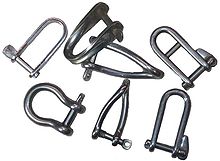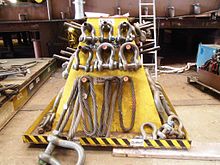Shackle
A shackle (Malotte, colloquially also cow's mouth or shackle hook ) is a U-shaped bracket that can be locked with a screw or socket pin to connect two parts.
application
Shackles are mainly used to absorb tensile forces when ropes , wire ropes or chains are transferred to fixed components. The bolts are often secured with nuts or split pins . The use of a shackle makes it easier to replace a damaged wire rope or chain. The curved shape makes the connection more flexible.
Shackles are mainly used in shipping , but also in conveyor technology and mechanical engineering .
A shackle is mostly made of steel or stainless steel . Casting and forging can be used as manufacturing processes .
Curly shackles
Shackles are standardized, for example in DIN 82016, as curved loading shackles. A distinction is made here between type A with a bolt screwed into the shackle eye and type B with bolt and nut, but also the nominal sizes. These range from 80 kN (≈8 t ) to 1000 kN (≈100 t) as standard sizes. The most important dimensions are the inner width, the clearance height and the bolt diameter.
Straight shackles
The straight shackles described in the DIN 82101 standard have a different shape. These are manufactured in forms A (nominal size 0.06 to 20) with a bolt screwed into the shackle eye, form B (0.4 to 20) with a countersunk bolt and form C (1 to 20 and 25 to 100) with a bolt with nut .
High strength shackles
There are also shackles made of high-strength material, which have a smaller size and lower weight with the same load-bearing capacity. For exceptionally high loads, high-strength shackles are also manufactured for payloads over 1000 tons. If the connection has to be loosened frequently, snap hooks or snap shackles are usually used.
Rope shackle
| Rope diameter | strength | Weight |
|---|---|---|
| 6 mm | 2200 daN | 24 g |
| 8 mm | 3800 daN | 41 g |
In contrast to the classic shackles, rope shackles are made of synthetic fiber rope. Usually an eye is spliced into a short piece of linen (about 1 m) made of single braid at one end and a diamond knot is tied at the other end . If the knot is now put in the eye, it will tighten under load and thus form a very light and strong rope shackle. One material used is Dyneema , a polyethylene fiber that is 12 times stronger than steel for the same weight. Dyneema is ideal for making particularly light shackles that even float.
literature
- Klaus Hoffmann, Erhard Krenn, Gerhard Stanker: conveyor technology. Volume 1: Components - their construction and calculation. seventh edition. R. Oldenbourg Verlag, Vienna / Munich 2005, ISBN 3-486-63059-8 .
- R. Hänchen: Winches and cranes. Construction - calculation and construction. Published by Julius Springer, Berlin 1932.
- Christof Linde: knots, stitches, bundles and slings. Verlag eco med Sicherheit, Munich 2011, ISBN 978-3-609-62402-0 .
Web links
- Shackles according to EN 13889 (accessed on July 16, 2020)
- DGUV-Information 215-313 Loads over people (accessed on July 16, 2020)
- Shackles & turnbuckles (accessed on July 16, 2020)
- Accident prevention regulations for load handling devices in hoist operation (accessed on July 16, 2020)
- BG-Information 772 - Hand-operated work seats (accessed on July 16, 2020)
Individual evidence
- ↑ Heavy-duty shackles ( memento of October 14, 2011 in the Internet Archive ), Anker Schroeder
- ↑ Self-made rope shackles . Skipper Markus, February 6, 2010.





